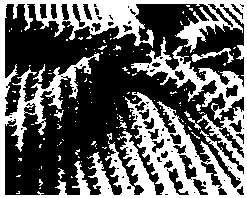Designing-weaving and dyeing-finishing treatment method for home textile end-and-end fabric or thick fabric
A processing method and fabric technology, applied in textiles and papermaking, textiles, fabrics, etc., can solve the problems of inconsistent shrinkage in warp and weft, inconsistent shrinkage in warp and weft, and different shrinkage rates of finished products, so as to speed up production efficiency, reduce labor costs, reduce The effect of energy consumption and waste discharge
- Summary
- Abstract
- Description
- Claims
- Application Information
AI Technical Summary
Problems solved by technology
Method used
Image
Examples
Embodiment 1
[0045] Taking the hollow fabric as an example, the design weaving and dyeing and finishing treatment method includes the following steps:
[0046] Design and weaving: selection of raw materials - warping - sizing - drawing in harness and reeding - machine;
[0047] Dyeing and finishing steps: gray fabric preparation—turning seam—singeing—desizing—scouring—bleaching—folding and setting—mercerizing—cold pile dyeing or printing—open width washing machine washing—drying—stenter softness—shrinking—inspection all;
[0048] Finishing: cutting - sewing finished product - washing machine enzyme water - tumble drying.
[0049] details as follows:
[0050] Design and weaving: the selection of raw materials, the selection must meet all the conditions of production and processing, such as the strength of raw materials. Hollow fabrics have higher requirements on fiber strength, and you can choose to contain chemical fibers or double-ply yarns. The design specification is T45 / C55 40*C60 / ...
Embodiment 2
[0076] When the fabric was a dense fabric, its design weaving and dyeing and finishing treatment method were the same as in Example 1, and the difference in specific process parameters was as follows:
[0077] In the selection of raw materials, thicker cotton yarns can be selected according to the fact that thick fabrics do not require high fiber strength. The design specification is C60*(C16+C10+C10 / 4)173*80 three-ply jacquard; the weft arrangement is C16:C10:C10 / 4=1:2:1; drafting and reeding: 2520 needles in the upper left corner of jacquard Starting and wearing, number of inserts: 4 inserts.
Embodiment 3
[0079] When the fabric is to change warp and weft type dense fabrics, its design weaving and dyeing and finishing treatment method are the same as embodiment 1, and the difference on the specific process parameters is as follows:
[0080] In the selection of raw materials, according to the change of warp and weft density, fabrics have higher requirements for warp strength, and pure cotton blended yarns can be selected. The design specification is C40 / T60 80 / 2*40 173*(120+100) jacquard fabric.
PUM
 Login to View More
Login to View More Abstract
Description
Claims
Application Information
 Login to View More
Login to View More - R&D
- Intellectual Property
- Life Sciences
- Materials
- Tech Scout
- Unparalleled Data Quality
- Higher Quality Content
- 60% Fewer Hallucinations
Browse by: Latest US Patents, China's latest patents, Technical Efficacy Thesaurus, Application Domain, Technology Topic, Popular Technical Reports.
© 2025 PatSnap. All rights reserved.Legal|Privacy policy|Modern Slavery Act Transparency Statement|Sitemap|About US| Contact US: help@patsnap.com



